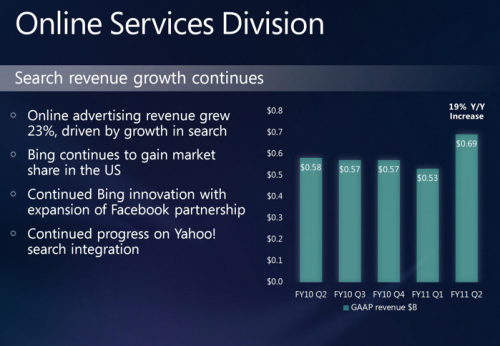Microsoft Q2 Revs Almost $20 Billion, “Bing Division” Still Losing Money Despite Search Revenue Increase
Microsoft announced second quarter earnings yesterday, which beat Wall Street’s expectations. The company reported a lot of good news about its revenues, profits and products, including Windows (PC) 7, Kinect/Xbox and Office. However Online Services, which houses all Microsoft’s online operations including MSN and Bing, posted a $543 million loss. That’s up from $463 a […]
Microsoft announced second quarter earnings yesterday, which beat Wall Street’s expectations. The company reported a lot of good news about its revenues, profits and products, including Windows (PC) 7, Kinect/Xbox and Office. However Online Services, which houses all Microsoft’s online operations including MSN and Bing, posted a $543 million loss. That’s up from $463 a year ago.
The company is on track to lose $2 billion for the year in that division, though ad revenues are up 23 percent.
There was very little discussion of search in particular or Windows Phones except for the following comments made on the earnings call by CFO Peter Klein.
On search:
Well, we’re extremely focused on doing what we need to do to be successful in that business. And we’ve been laser beam focused on what that is. One is growing our Search share and the other is growing our revenue per search. And we continue to grow our share every quarter. We’re going to continue to focus on that. We’re going to do a lot of things, a lot of the same things that we’re doing to that. Bill talked about some of the product enhancements. I think that’s probably the more important thing we can do to really differentiate the product experience because I think that’s really what drives usage and share in Search. And then of course, on the revenue per search side, the Yahoo! integration is the key component of that, and we’re excited to move forward in that. But really on the share side, I mean, we’ll do interesting marketing things like we have been doing. But I think what I’m really get excited about is product enhancement with some of the partnerships we’ve got there.
On Windows Phones:
Also during the quarter, we launched Windows Phone 7, which is now on nine devices with 60 operators in 30 markets. We said all along that our first priority was to make a phone people love, and to that end, we’re pleased with the initial response. Customer satisfaction data indicates 93% of customers worldwide are happy with the product, and we’re also seeing strong developer engagement. While we’re encouraged by the early progress, we realize we still have a lot of work ahead of us, and we remain focused and committed to the long-term success of Windows Phone 7 . . .
Windows Phone 7 is off to a solid start as handset manufacturers purchased over 2 million licenses in the quarter. Windows Phone 7 is making progress in its early days as user satisfaction is extremely high, and developer momentum has continued to build to now over 24,000 registered developers. As we announced at CES, we are looking forward to adding more features including support for CDMA.
The two products have a good deal in common in that both are underdogs (especially Windows Phones) and both represent long-term strategic bets for the company. The “over 2 million licenses” that Microsoft sold does not mean that over two million handsets were actually sold to consumers. However the customer satisfaction numbers cited must be encouraging.
The question of the impact of tablets (read: iPad) on PC sales was largely dismissed.
Related posts:
Contributing authors are invited to create content for Search Engine Land and are chosen for their expertise and contribution to the search community. Our contributors work under the oversight of the editorial staff and contributions are checked for quality and relevance to our readers. The opinions they express are their own.
Related stories
New on Search Engine Land

